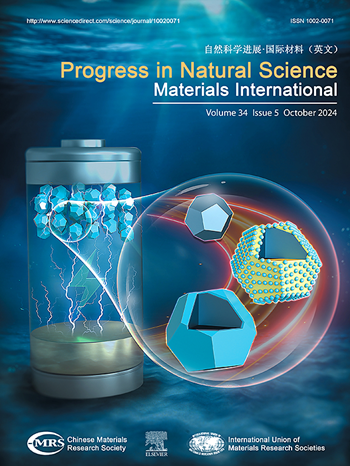Decoupling opposed thermoelectric parameters via multilayer structure in Bi2Te3-based films
IF 7.1
2区 材料科学
Q2 MATERIALS SCIENCE, MULTIDISCIPLINARY
Progress in Natural Science: Materials International
Pub Date : 2025-04-01
DOI:10.1016/j.pnsc.2025.01.003
引用次数: 0
Abstract
Highly conductive metal layers Cr and Al are introduced to prepare multilayer thermoelectric films of Bi2Te3/Al and Bi2Te3/Cr. XRD precipitations and Raman bonding reveal the interfacial stability between the Bi2Te3 and Al layers. The multilayer structure's interfacial effect breaks the coupling between the electrical conductivity and the Seebeck coefficient, both of which exhibit a steady upward trend as temperature rises. This directly contributes to the high power factor of 520.8 μW/mK2 for Bi2Te3/Al that is produced at 600 K. On the other hand, Bi2Te3 tends to react with Cr as temperature rises, and at 600 K, the optimal carrier concentration following interdiffusion results in a maximum PF of 199.0 μW/mK2. By comparison, they are both almost six times and two times better than pure Bi2Te3, respectively. Overall, this work improves Bi2Te3 by introducing the metals Al and Cr with constructing a multilayer structure. It also offers a straightforward and user-friendly method for utilizing interfacial engineering to optimize the thermoelectric properties of thin films.
利用多层结构对bi2te3基薄膜的热电参数进行解耦
采用高导电性金属层Cr和Al制备了Bi2Te3/Al和Bi2Te3/Cr多层热电薄膜。XRD沉淀和拉曼键合揭示了Bi2Te3和Al层之间的界面稳定性。多层结构的界面效应打破了电导率和塞贝克系数之间的耦合关系,两者都随着温度的升高而呈现稳定的上升趋势。这直接有助于在600 K时产生的Bi2Te3/Al的高功率因数为520.8 μW/mK2。另一方面,随着温度的升高,Bi2Te3倾向于与Cr发生反应,在600 K时,经互扩散后的最佳载流子浓度可获得最大PF为199.0 μW/mK2。相比之下,它们分别比纯Bi2Te3好近6倍和2倍。总的来说,本工作通过构建多层结构,引入金属Al和Cr来改进Bi2Te3。它还为利用界面工程优化薄膜热电性能提供了一种简单易用的方法。
本文章由计算机程序翻译,如有差异,请以英文原文为准。
求助全文
约1分钟内获得全文
求助全文
来源期刊
CiteScore
8.60
自引率
2.10%
发文量
2812
审稿时长
49 days
期刊介绍:
Progress in Natural Science: Materials International provides scientists and engineers throughout the world with a central vehicle for the exchange and dissemination of basic theoretical studies and applied research of advanced materials. The emphasis is placed on original research, both analytical and experimental, which is of permanent interest to engineers and scientists, covering all aspects of new materials and technologies, such as, energy and environmental materials; advanced structural materials; advanced transportation materials, functional and electronic materials; nano-scale and amorphous materials; health and biological materials; materials modeling and simulation; materials characterization; and so on. The latest research achievements and innovative papers in basic theoretical studies and applied research of material science will be carefully selected and promptly reported. Thus, the aim of this Journal is to serve the global materials science and technology community with the latest research findings.
As a service to readers, an international bibliography of recent publications in advanced materials is published bimonthly.

 求助内容:
求助内容: 应助结果提醒方式:
应助结果提醒方式:


